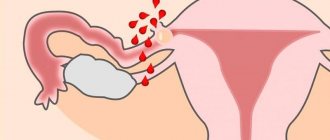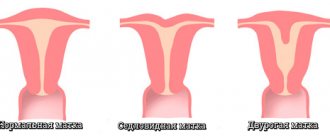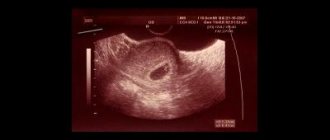While some women dream of carrying and giving birth to a child, others are looking for ways to terminate an unwanted pregnancy. Modern medicine and pharmacology provide a huge selection of contraceptives that can prevent conception, but despite this, the number of abortions performed by doctors is constantly growing. According to statistics, about 20 thousand women a year get rid of an unwanted pregnancy. It is difficult to give this act an unambiguous moral assessment, however, from a scientific point of view, an embryo is the first stage of development of the human body and is fully equated to a newborn child, and abortion is murder. Morality does not force a woman to forcibly follow her own interests, but demands that she take responsibility for her actions without paying with the life of an unborn person. On the other hand, such a serious medical intervention as abortion always has an extremely detrimental effect on the woman’s body, especially on the organs of the reproductive system. The consequences can be extremely dire, ranging from hormonal imbalance and the development of various neoplasms, ending with infertility. Therefore, if a woman has doubts about carrying out this procedure, first of all, it is necessary to consult a gynecologist who will tell you about all the possible risks. There are certain periods at which the procedure can be carried out by medical professionals, and various types of abortions are offered; let’s look at them in more detail.
What is a medication method?
Replacing the surgical instrument and vacuum aspirator with hormonal drugs made it possible to develop a method of pharmacological abortion. This is a non-invasive procedure for getting rid of pregnancy in the early stages, which occurs like a spontaneous miscarriage.
Its advantages are associated with the following factors:
· efficiency 98-99%;
· no possibility of injury to the uterus or cervix during surgical procedures;
· low risk of ascending infection;
· there is no danger of getting HIV, hepatitis;
· no risks caused by anesthesia;
· can be used in primigravidas, the effect on women’s health is minimal;
· low level of stress, does not create a traumatic situation.
The procedure does not require a long hospital stay. After the patient has taken medications that cause a medical abortion, bleeding can be expected at home. But self-administration of medications without a doctor is impossible.
Which is better, vacuum abortion or medical abortion?
This is decided individually. But the complications and degree of interference in the body with vacuum aspiration are much higher.
Medical termination of pregnancy. Abortion without surgery
Until the end of the 80s of the last century, the choice of methods for terminating an unwanted pregnancy
was, to put it mildly, small and the question suggested an unambiguous answer - abortion or, in everyday life, “cleansing”. With the introduction of vacuum aspiration (“mini-abortion”) into medical practice in the 90s, women had the opportunity to avoid the traumatic procedure of a traditional abortion and, if time allowed, get by with “little blood.” At the same time, a method of non-surgical abortion appears in the West, which quickly gained great popularity. Suffice it to say that in France, the birthplace of the drug Mifegin, about 80% of women prefer this method.
Current clinical experience with medical abortion
accumulated in France, England, Germany, Sweden, USA, India. Now Russian women can use this method.
Indications and benefits of medical abortion
1. Termination of short term pregnancies (up to 6-7 weeks)
- is characterized by high efficiency, reaching in some cases up to 95%;
- avoids the risks associated with anesthesia and surgery;
- eliminates the risk of infection, development of adhesions, and obstruction of the fallopian tubes;
- preserves the uterine cavity;
- eliminates the possibility of infection with hepatitis B virus, HIV;
- allows for voluntary termination of pregnancy at a very early stage;
- is very well psychologically accepted by patients who have very ambivalent perceptions of abortion;
- causes moderate pain and uterine contractions.
- is the drug of choice for abortion in primigravidas and at a young age.
2. Preparation for later termination of pregnancy
- simplifies a number of operations that must be performed surgically, making them easier and causing less injury;
- allows the use of local anesthesia instead of general;
- reduces the duration of the operation due to increased contractility of the uterine muscle, leading to a decrease in blood loss during surgery;
- relaxation of the cervix facilitates the expansion of the cervical canal and reduces the risk of damage to the muscular apparatus of the cervix and, as a consequence, the development of cervical insufficiency during subsequent pregnancy and childbirth.
- relaxation of the cervix with increased uterine tone reduces the possibility of developing the accumulation of blood clots in the uterine cavity and inflammatory diseases in the postoperative period.
3. Urgent (postcoital) contraception
- prevention of unwanted pregnancy within 72 hours after “unprotected” sexual intercourse.
Possible complications of medical abortion
The main complication is the complete or partial absence of an abortifacient effect. The number of unsatisfactory outcomes, according to various authors, ranges from 5% to 12.5% and depends on the patient’s individual response to the drug and is directly dependent on the duration of pregnancy. With a longer period, the number of unsatisfactory outcomes increases.
Of these: from 1 to 2.5% - cases of ongoing pregnancy, from 3 to 7.5% - interrupted pregnancy, but without expulsion of the ovum, or incomplete expulsion from 1 to 2.5% - increased bleeding requiring intrauterine intervention
If the fact of an unsuccessful attempt is established and the pregnancy continues to progress, the patient may be offered another method of termination.
Contraindications to medical abortion
- suspected ectopic pregnancy;
- chronic adrenal insufficiency;
- long-term therapy with corticosteroids;
- individual intolerance to mifepristone;
- hemorrhagic disorders (hemophilia, grade II-III anemia, hemorrhagic syndromes);
- use of anticoagulants (heparin);
- pregnancy that occurred while using intrauterine contraception;
- infectious, inflammatory processes of the genitals in the acute stage;
- severe forms of bronchial asthma and obstructive pulmonary diseases;
- inflammatory bowel diseases (enteritis, colitis, gastritis, cholecystopancreatitis);
- liver failure;
- prosthetic heart valves, infective endocarditis in the past;
With caution it is possible to:
- smoking women over 35 years of age (more than 10 cigarettes per day) - after consulting a therapist;
- asymptomatic uterine fibroids;
- sutures on the uterus after surgery;
- arterial hypertension (hypertension);
- lactation - breastfeeding should be stopped for 14 days after taking the drug
Stages of medical abortion
Stage 1
- After the patient indicates the presence of an unwanted pregnancy and the desire to terminate it, possible solutions to the problem are discussed. If you choose this method, information is provided about the essence of the method, contraindications, possible side effects, symptoms and possible options for the course of the abortion.
- Necessary examination: medical history, initial examination, CHG (if indicated).
- Providing time for the final decision to terminate pregnancy in general and by medical method
Stage 2
- Confirmation by the patient of the desire to terminate the pregnancy using this method. Filling out the patient's informed consent sheet for the use of the drug.
- Taking the drug "Mifegin" R (Pencrofton) and dynamic observation for 1-2 hours.
- If vomiting occurs during this time, the desired result will probably not be achieved and termination of the pregnancy will need to be accomplished in another way. After taking Mifegin (Pencrofton) for 36 to 48 hours, the appearance of cramping pain and bleeding from the genital tract is expected and possible.
Stage 3
- After 36-48 hours, support drugs (prostaglandins) are prescribed. In most cases, abortion occurs within 4-8 hours. Pain and the degree of bleeding can vary in intensity and duration, and with a longer period they are more pronounced.
- Bleeding and pain are not a guarantee that an abortion has occurred. Therefore, it is absolutely necessary to carry out a follow-up examination using appropriate methods 8-14 days after taking Mifegin (Pencrofton).
Stage 4
- Follow-up consultation - based on follow-up studies (ultrasound or examination), the result is determined. If the pregnancy continues or there are residual fertilized eggs in the uterine cavity, appropriate intervention may be recommended. If the outcome is positive, contraception must be used, since fertilization can occur before the start of the menstrual cycle.
How is the time for an abortion determined?
The timing for medical abortion is determined by the protocol of the Ministry of Health of the Russian Federation dated October 14, 21015. They record that it is possible to carry out a gestational disorder up to 63 days, or the 9th week. But in world practice there are differences in how long this manipulation can be done. In developed countries, the period is defined as 49 days, or 7 weeks of pregnancy.
Why is such a period determined for pharmacological interruption?
At the 5th week of pregnancy, the embryo begins to acquire human features, the rudiments of many organs and the umbilical cord appear. At week 6, the placenta begins to form, and internal organs continue to develop. At week 8, the embryo already has a completely human appearance and enters the fetal stage. After this period, the formation of blood vessels in the placenta occurs, so a medical abortion can cause heavy bleeding.
The following drugs for medical abortion are registered and used in Russia:
1. Mifepristone 200 mg.
2. Misoprostol 200 mcg.
Pharmacological abortion during a frozen pregnancy can be used if the gestational age corresponds to that permitted by the protocol. The main condition for the successful completion of the procedure is the day of pregnancy and the presence of an embryo inside the uterus according to ultrasound results. After a caesarean section, the medical method is preferable to other methods.
What kind of pain relief is used?
To ensure that the process takes place with minimal discomfort, anesthesia is used. It allows you to relieve pain. Choosing the appropriate option is the responsibility of a specialist. He takes into account medical indications and features of the upcoming intervention.
For surgical abortion, general anesthesia is provided. The woman is put into a state of medicated sleep, which ensures complete relaxation of the muscular system. There is no pain, which allows specialists to carry out their work. Before this, examinations are carried out to identify possible contraindications. First of all, we are talking about analyzes of biological fluids and ECG. As an addition, in some cases an ultrasound examination/flora smear is prescribed.
The presence of serious diseases affecting the liver, cardiovascular system, as well as drug addiction and alcoholism are reasons for refusing general anesthesia. If no contraindications are found, then begin administering the drug. Intravenous infusion is practiced. The dosage is calculated taking into account the duration of the event.
In any case, a consultation with an obstetrician-gynecologist is necessary, who will help determine the possibility of terminating the pregnancy and select the safest method.
Preparation for the procedure
When you first visit a gynecologist, you need to conduct a general examination, a bimanual examination on a chair and in mirrors, and vaginal smears are taken. Blood pressure, pulse, and respiratory rate are also measured. Next, the woman is sent for an ultrasound to determine the exact day of gestation, the condition of the uterus, and the fertilized egg.
Referrals are given for blood, urine, glucose, and ECG tests. A coagulogram is prescribed if there is a history of problems with the blood coagulation system. Additional examination methods may be needed, the need for which is determined by the doctor.
When visiting the obstetrician-gynecologist again, the patient signs consent to perform an induced abortion using pharmacological drugs.
The signs of an abortion are identical to a spontaneous miscarriage. A woman feels a cramping stomach ache and menstrual-like discharge appears.
How long does the bleeding last?
For most women, it lasts 7-9 days. Blood discharge after the procedure is rarely observed until the next menstruation. If the manipulation is carried out for a period of 3-4 weeks, then bleeding is not much different from menstruation. As the period increases, the release of blood increases; sometimes the use of hemostatic therapy may be required.
After 14 days you need to appear for a follow-up examination. This is necessary to confirm that the interruption has occurred. If an unsuccessful medical abortion occurs, aspiration from the uterus is prescribed.
What are the main indications?
to have an emergency abortion when she is no more than 12 weeks pregnant. In addition to the personal desire expressed by the client, there are several indications:
- identification of certain diseases included in a special medical list;
- developmental pathologies, fetal death;
- ectopic pregnancy;
- pregnancy after rape;
- social indications (loss of husband during pregnancy, asocial lifestyle of the mother, as a result of which the birth of a child with serious disabilities is possible).
Possible complications
Despite the small number of complications, it is possible to determine why medical abortion is dangerous. In 85% of cases, adverse reactions in the form of abdominal pain and bleeding are moderate and no special treatment is required.
In other cases, manipulation can lead to the following complications:
· severe pain syndrome;
· profuse bleeding;
· temperature;
· incomplete abortion;
· progressive pregnancy.
Pain in the lower abdomen is observed during the period of expulsion of abortion products. Its intensity may vary, but the individual tolerance threshold also matters.
Bleeding is considered significant if you have to change two pads in an hour, and this condition lasts for at least 2 hours. In this case, vacuum aspiration of the contents of the uterus is indicated in order to stop it. In severe cases, surgical cleaning is performed.
In 2-5% of cases, medical abortion is incomplete. Then it is also necessary to perform vacuum aspiration or curettage of the uterine cavity. Less than 1% of cases result in pregnancy progression. If a woman insists on an abortion, then invasive methods are used. Those who have changed their decision must be informed about the possible teratogenic effect of the drugs on the fetus. But there is not enough data to confirm this fact.
Taking medications may cause a slight increase in temperature, but this lasts no more than 2 hours. If the fever lasts for 4 hours or more or occurs one day after taking Misoprostol, this indicates the development of an infectious process. A woman with these symptoms should consult a doctor.
Other complications in the form of dyspeptic symptoms may be a sign of pregnancy itself. For allergic reactions, treatment with antihistamines is necessary.
Help from a gynecologist during pregnancy
ATTENTION:
Online consultations with doctors (more than 18 specialties) are available.
Termination of pregnancy may be required in various situations - it may be unwanted or undesirable for health reasons. In order for the procedure to take place without consequences and with minimal health risks, many women resort to medical termination of pregnancy. It is carried out in the early stages of fetal development. This approach helps preserve a woman’s reproductive health.







